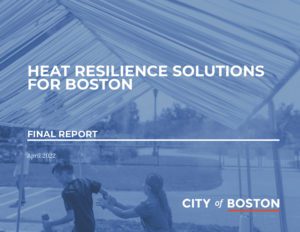Who is a member?
Our members are the local governments of Massachusetts and their elected and appointed leadership.
 As a part of the much larger campaign to address climate change readiness in the city, Mayor Michelle Wu announced a citywide framework to address hotter summers and an increasing number of dangerous heat events.
As a part of the much larger campaign to address climate change readiness in the city, Mayor Michelle Wu announced a citywide framework to address hotter summers and an increasing number of dangerous heat events.
“Heat threatens the health and well-being of our residents, of our infrastructure, and our environmental justice communities like right here in Chinatown are especially vulnerable,” Mayor Wu said during a press conference.
The heat plan, Heat Resilience Solutions for Boston, builds on the 2016 Climate Ready Boston plan, which encompasses a much larger effort to prepare the city for near- and long-term effects of climate change. The heat plan is also designed to work in concert with the city’s Urban Forest Plan.
The plan lays out 26 strategies organized into two sections — relief during heat waves and creating cooler communities — and includes both long-term and short-term initiatives. The plan provides an implementation roadmap, including the launch of an interdepartmental Extreme Temperatures Response Task Force, which will be supported by the city’s Environment Department, the Office of Emergency Management, and the Boston Public Health Commission’s Office of Public Health Preparedness.
The heat plan focuses on five environmental justice communities that are hotspots: Chinatown, Dorchester, East Boston, Mattapan and Roxbury. The planning process included analyzing historical development practices, including redlining and land use, to understand neighborhoods and the impact of systemic inequalities, with the goal of ensuring that everyone can access cooling resources.
“We understand that our environmental justice communities disproportionately feel the impacts of climate change and compound factors of inequality,” said Zoe Davis, program coordinator for the Heat Resilience Study. “We can deliver more just outcomes.”
The plan, released on Earth Day (April 22), took nearly two years to develop, funded in part by the state’s Municipal Vulnerability Preparedness grant program.
“Extreme heat was identified in the 2016 climate ready plan, and a lot of previous work had been focused on flooding,” Davis said. “After the summer of 2019, which at the time was one of Boston’s hottest summers, we recognized the need to develop a plan to deal with heat resiliency.”
The plan was made possible by cross departmental collaboration, partnership with consultants, and significant community engagement, including virtual open houses, a citywide survey, a youth forum and a community advisory board, all of which were adjusted to succeed despite in-person limitations during the pandemic.
Davis called the community advisory board “a really valuable part of the process … by informing the process and building relationships and ensuring that community voices are closer to the process and that there is a sense of agency. We have community leaders who are experts on certain experiences and we value that resource.”
The project team conducted a citywide heat analysis to develop the data-driven plan. The team isolated a weeklong period from the summer of 2019 to create models of daytime and nighttime air temperatures, heat event durations, and an urban heat island index, which reflects the impact of the built environment on heat. Pavement, roofing material, density and lack of green space and trees can all increase urban heat island effects.
The plan also looks at the impact of extreme heat on transit and energy infrastructure, like the warping of steel rail tracks, buckling of concrete and power outages.
The city is taking short-term steps to offer relief during heat waves, with a number of pilot projects including distributing popup cooling kits to organizations that host outdoor events during the summer and a cool roof grant program to help property owners learn about and install cool roofs.
“We are thinking about integrating heat resilience into major building projects, at the neighborhood level and district level, but also thinking about governance and implementation, like zoning laws, and about education and bringing climate into those conversations,” Davis said.
“It is making sure Boston can thrive in the context of a changing climate.”